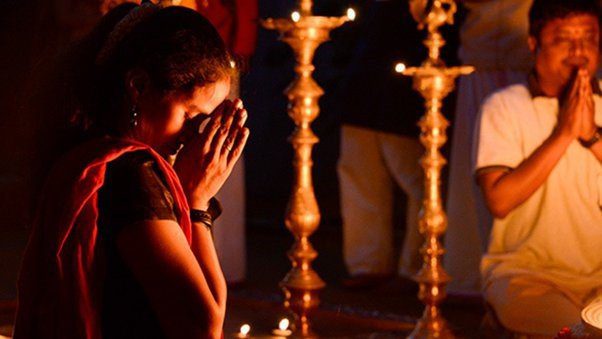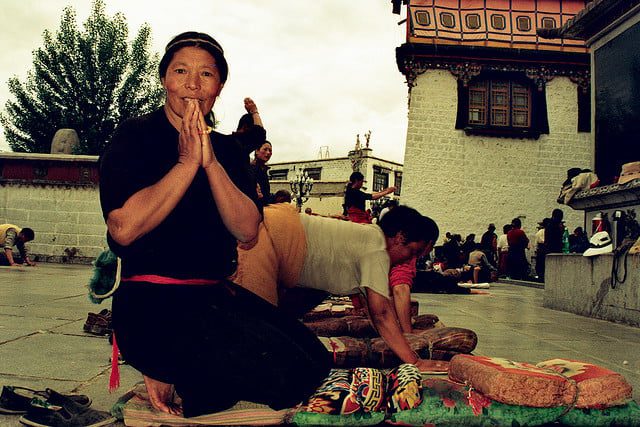What is Namaste? Understanding the Traditional Indian Greeting
“Namaste” is a greeting commonly used in India and Nepal, which is derived from the Sanskrit language.
Namaste is a greeting commonly used in India and Nepal, derived from the Sanskrit language. This gesture, performed by pressing the palms together and bowing slightly, signifies respect and reverence. It symbolizes the belief that there is a divine spark within each of us. Namaste is not just a form of greeting but a way of expressing respect to others, humility, affection, and connection.
Why do people say Namaste? Cultural Significance and Usage
People say Namaste as a sign of respect and greeting, acknowledging the divine within each person. It is used in both formal and informal settings, often accompanied by a slight bow. The gesture fosters a sense of unity and spiritual connection, transcending cultural and religious boundaries. In yoga and meditation practices, Namaste is a way to express gratitude and respect to oneself and others.

The Traditional Way to Say Namaste: Steps and Meanings
It is often accompanied by a slight bow or placing the palms of the hands together in front of the chest, fingers pointing upwards, with the thumbs touching the sternum.
The traditional way to say Namaste involves pressing the palms together in a prayer-like gesture, with fingers pointing upwards, and bowing slightly. This gesture is accompanied by the spoken word “Namaste.” The bow signifies respect and humility towards the other person.

This gesture is called “anjali mudra” or “pranamasana,” and it is believed to represent the joining of the left and right sides of the body, which symbolizes the union of the individual self with the divine.
Namaste has a cultural significance in India and Nepal, where it is commonly used as a respectful greeting in both formal and informal settings.
It is also a way to acknowledge the divine within the person being greeted and to promote a sense of humility and the sense of connection between the two.
There are similar customary greetings in other cultures. For example, in Japan, people commonly bow as a sign of respect when greeting others, and in Thailand, people place their hands together in a prayer-like gesture and bow slightly as a sign of respect. In many Western cultures, shaking hands is a common way to greet others, and hugging is also becoming more popular.
Namaste: Meaning and Spiritual Interpretation
Namaste is a greeting used in many cultures, but it originally comes from Sanskrit. It’s actually two words put together:
- Namah (pronounced nuh-MAH) which means “bow” or “show respect”
- Te (pronounced teh) which means “to you”
So literally, namaste means “I bow to you.”
But it’s not just a physical bow. It expresses a deeper respect and acknowledges the divine presence in both the person greeting and the person being greeted.
“The Divine within me bows to the same Divine within you.”
In spiritual contexts, Namaste recognizes the interconnectedness of all beings and the shared sacredness of life. The term encapsulates the essence of unity, peace, and mutual respect.

Namaskar: Meaning and Difference from Namaste
Namaskar is another traditional Indian greeting, often used interchangeably with Namaste. It carries a similar meaning, denoting respect and reverence.
While Namaste is more commonly used in everyday interactions, Namaskar is considered slightly more formal and is often used in religious and ceremonial contexts. Both greetings reflect the same underlying principles of recognizing and honoring the divine within each person.
Namaskar is a respectful greeting or parting salutation in Hindu and yogic traditions. The word is derived from the Sanskrit base namaha, which means “not me” and refers to bowing in reverence.
How is Namaskar Different from Namaste?
Namaskar is sometimes considered a synonym of namaste, but there are subtle differences in their meanings.

Namaste is the more popular and informal term, meaning “salutations to you” or “I bow to you with respect”, while namaskar is more formal and translates as “I pay my salutations”.
Namaskar is composed of three Sanskrit words:
- Nam, which means “to bow to”
- As, which means “to be” or “to exist”
- Kar, which means “doing” or “one who does”
Namaskar, therefore, is sometimes translated as “I do the act of bowing with reverence.”

Regional Variations of Namaste and Namaskar in India
Despite these regional differences, the underlying principle of respect and reverence remains the same. These variations highlight the rich cultural diversity of India while maintaining the core essence of the greeting.
Here are a few examples of how people say “Namaste” or “Namaskar” in different Indian languages:
- Hindi: नमस्ते (Namaste) – This is the standard greeting in Hindi and is widely used across India.
- Marathi: नमस्कार (Namaskar) – This is the standard greeting in Marathi, which is spoken in the state of Maharashtra.
- Bengali: নমস্কার (Nomoshkar) – This is the standard greeting in Bengali, which is spoken in the eastern region of India, including the state of West Bengal.
- Tamil: வணக்கம் (Vanakkam) – This is the standard greeting in Tamil, which is spoken in the southern state of Tamil Nadu.
- Telugu: నమస్కారం (Namaskaram) – This is the standard greeting in Telugu, which is spoken in the southern state of Andhra Pradesh.
- Kannada: ನಮಸ್ಕಾರ (Namaskara) – This is the standard greeting in Kannada, which is spoken in the southern state of Karnataka.
- Gujarati: નમસ્તે (Namaste) – This is the standard greeting in Gujarati, which is spoken in the western state of Gujarat.
- Punjabi: ਸਤ ਸ੍ਰੀ ਅਕਾਲ (Sat Sri Akal) – This is a traditional greeting in Punjabi, which is spoken in the northern state of Punjab. It means “Truth is the ultimate reality.”
Learn More about languages from India
It’s worth noting that there may be regional variations in how people say “Namaste” or “Namaskar” in different parts of India, and there may be additional greetings or expressions used in different contexts or situations.
The Origins of Namaste
Namaste traces its roots back to ancient Indian texts like the Vedas and Upanishads, where it was used as a respectful greeting among sages and scholars. Over time, it became an integral part of Indian culture, symbolizing the recognition of the divine spark within each individual. The gesture and the word itself have evolved to represent a universal symbol of peace and respect.
The Significance of Namaste in Yoga
In yoga practice, Namaste is used to express gratitude and respect to oneself and others. It is commonly used at the beginning and end of a yoga session, fostering a sense of community and shared spiritual practice. The gesture helps center the mind and body, preparing practitioners for deeper meditation and self-awareness.
Glossary of Terms
- Namaste: A traditional Indian greeting meaning “I bow to you,” symbolizing respect and acknowledgment of the divine within each person.
- Namaskar: A more formal version of Namaste, often used in religious and ceremonial contexts.
- Yuj: A Sanskrit root word meaning “to yoke” or “to unite,” from which the word “yoga” is derived.
- Upanishads: Ancient Indian texts that form the philosophical basis of Hinduism and discuss the nature of reality and the self.
- Vedas: The oldest sacred texts of Hinduism, containing hymns, philosophy, and guidance on ritual.
Traditional Greetings Elsewhere
Here are a few examples of greetings similar to “Namaste” from around the world:

Thailand: สวัสดี (Sawatdee) – This is a common greeting in Thai, which is spoken in Thailand. It’s often accompanied by a wai, which is a gesture where the hands are placed together in a prayer-like position and raised to the chest or forehead. Source

Japan: こんにちは (Konnichiwa) – This is a common greeting in Japanese, which is spoken in Japan. It’s often accompanied by a bow, which can range from a slight nod of the head to a deeper bow depending on the formality of the situation.

Indonesia and Malaysia: Salam (Salam sejahtera in Malaysia) – “Salam” means “peace” in Arabic, and it’s used as a greeting in both Indonesia and Malaysia.


It’s often accompanied by a handshake, a bow, or the touching of hands to the chest. Source for images

Tibet: Tashi delek – This is a Tibetan greeting that means “auspicious blessings” or “good luck.” It’s often accompanied by a slight bow or putting the hands together in a prayer-like position.

Philippines: Mabuhay – This is a common greeting in Tagalog, which is spoken in the Philippines. It means “long life” or “welcome” and is often accompanied by a handshake or a slight bow.
